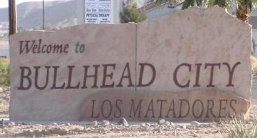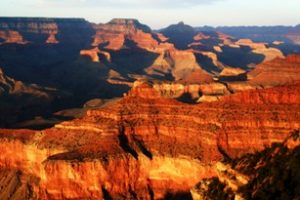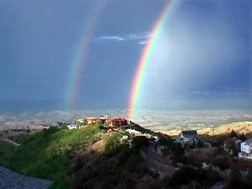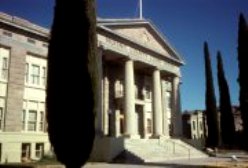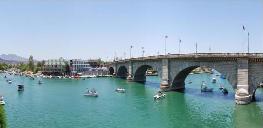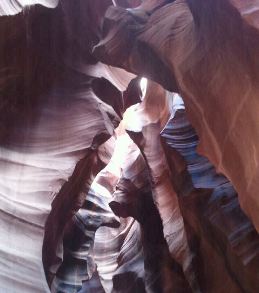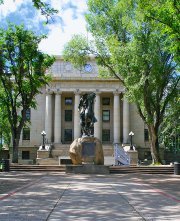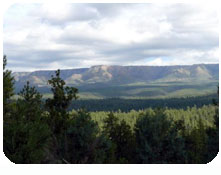Gay Northern Arizona Directory
Bullhead City: Sun, Fun, and River Adventures
Nestled on the east bank of the Colorado River, Bullhead City is a vibrant hub perfect for those who love water sports and year-round sunshine. Its close proximity to Laughlin, Nevada, means you’re just a stone’s throw away from exciting nightlife and entertainment. Whether you’re jet skiing, paddleboarding, or just relaxing by the river, Bullhead City offers a warm welcome and plenty of activities to keep you entertained.
Cottonwood: Wine, History, and the Arts
Cottonwood, surrounded by jagged mountains and lush mesas, is the heart of the Verde Valley. This charming town, with its historic Old Town, boasts numerous gay-owned businesses, including antique shops, fine restaurants, wine bars, and art galleries. Don’t miss the wineries and vineyards for a delightful tasting experience, and explore nearby attractions like the Verde Canyon Railroad and Tuzigoot National Monument. Cottonwood’s blend of history, culture, and natural beauty makes it a must-visit.
Flagstaff: Your Gateway to Natural Wonders
Flagstaff, just a short drive from the Grand Canyon, is an ideal base for exploring Northern Arizona’s most impressive natural sites. Enjoy cool summer weather and a bustling urban center with diverse dining, shopping, and nightlife options. Visit the Lowell Observatory, hike the San Francisco Peaks, or explore the historic Route 66. Flagstaff’s inclusive community and year-round recreation make it perfect for LGBTQ+ travelers seeking both adventure and comfort.
Grand Canyon: Awe-Inspiring and Unforgettable
The Grand Canyon is a bucket-list destination, renowned for its vast, awe-inspiring landscapes. This natural wonder offers various ways to explore, from hiking and mule rides to river rafting. With its LGBTQ+ friendly tours and services, you can enjoy this magnificent park feeling safe and welcomed. The sheer scale and beauty of the Grand Canyon are sure to leave a lasting impression.
Jerome: Artistic Vibes in a Historic Setting
Once a booming copper mining town, Jerome is now a thriving artist community perched on Cleopatra Hill. Known as the largest ghost town in America, Jerome is rich in history and character. Its many gay-owned businesses, from quirky shops to cozy cafes, create a welcoming atmosphere for all visitors. Explore the town’s galleries, museums, and breathtaking views, and soak in the unique charm of this high-desert gem.
Kingman: History and Outdoor Fun
Kingman offers a blend of historical intrigue and modern amenities. As a former railroad town, it boasts several museums, including the Mohave Museum of History and Arts. The surrounding mountains and the Colorado River provide ample opportunities for outdoor activities like hiking, golfing, and water sports. Kingman’s inclusive community and rich heritage make it a delightful stop on your Northern Arizona journey.
Lake Havasu City: Desert Beauty and Water Wonders
Lake Havasu City is an oasis in the desert, renowned for its sparkling waters and dramatic landscapes. Famous for the London Bridge, this city offers endless water-related activities, from boating to fishing. Explore hidden trails with ancient petroglyphs or take a leisurely cruise on an authentic paddlewheel boat. Interestingly, Lake Havasu City is known for having more lighthouses than any other city in the United States. The city boasts a collection of over two dozen lighthouses, which are replicas of famous lighthouses from across the country. These replicas serve as unique navigational aids for boaters on Lake Havasu and add to the city’s charm and appeal as a tourist destination. The welcoming vibe and stunning scenery make Lake Havasu City a perfect getaway for LGBTQ+ travelers seeking both relaxation and adventure.
Page: Gateway to Adventure
Page, located near the stunning Lake Powell and Antelope Canyon, is your go-to spot for outdoor excitement. Whether you’re hiking through the mesmerizing slot canyons or embarking on a Colorado River rafting trip, Page offers endless opportunities for exploration. The town’s proximity to Navajo Tribal lands adds a rich cultural dimension to your visit, with many gay-friendly businesses ensuring you feel right at home.
Prescott: Historic Charm in the Pines
Prescott, nestled in the cool pines, is steeped in history and natural beauty. Explore its historic downtown with a walking tour, visit the Sharlot Hall Museum, and enjoy the vibrant arts scene. Outdoor enthusiasts will love the 450 miles of recreational trails and numerous golf courses. Prescott’s charming inns and bed and breakfasts offer a cozy retreat, making it an ideal destination for LGBTQ+ travelers.
Rim Country: Nature’s Playground
The Rim Country, including towns like Payson, Pine, and Strawberry, offers pristine natural beauty and endless outdoor activities. Known for its Ponderosa pine forests, the region is perfect for hiking, bird watching, and exploring. The friendly locals and welcoming atmosphere make it easy to enjoy the stunning scenery and rich history, from Zane Grey’s cabin to ancient Indian ruins.
Sedona: Red Rock Romance and Spiritual Vibes
Sedona’s iconic red rocks and spiritual atmosphere attract visitors from around the world. Known as a premier wedding destination, Sedona offers luxurious resorts, fine dining, and a thriving arts scene. Outdoor activities abound, from hiking and biking to jeep tours. Whether you’re seeking adventure, relaxation, or a spiritual retreat, Sedona’s inclusive and welcoming community makes it a perfect spot for LGBTQ+ travelers.
Williams: Embrace Adventure and Charm
 Tucked away in the pine-scented forests of Northern Arizona, Williams is the perfect getaway for travelers seeking a blend of outdoor adventure and small-town charm. As the Gateway to the Grand Canyon, Williams offers a scenic and inclusive retreat with its historic Route 66 allure. Start your visit with a ride on the Grand Canyon Railway, a journey that’s as welcoming as it is breathtaking. Stroll through the vibrant downtown, where rainbow flags flutter outside cozy cafes, quirky boutiques, and vintage diners. Unwind at one of the LGBTQ+ friendly bed-and-breakfasts, where you’ll be greeted with genuine hospitality. Whether you’re hiking the beautiful trails, exploring Bearizona Wildlife Park, or simply enjoying the star-studded night skies, Williams promises an enchanting and inclusive experience for all.
Tucked away in the pine-scented forests of Northern Arizona, Williams is the perfect getaway for travelers seeking a blend of outdoor adventure and small-town charm. As the Gateway to the Grand Canyon, Williams offers a scenic and inclusive retreat with its historic Route 66 allure. Start your visit with a ride on the Grand Canyon Railway, a journey that’s as welcoming as it is breathtaking. Stroll through the vibrant downtown, where rainbow flags flutter outside cozy cafes, quirky boutiques, and vintage diners. Unwind at one of the LGBTQ+ friendly bed-and-breakfasts, where you’ll be greeted with genuine hospitality. Whether you’re hiking the beautiful trails, exploring Bearizona Wildlife Park, or simply enjoying the star-studded night skies, Williams promises an enchanting and inclusive experience for all.
Winslow: A Welcoming Oasis for Travelers on Route 66
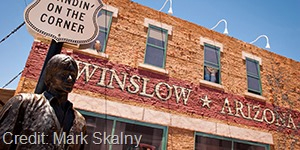 Nestled along historic Route 66, Winslow, Arizona, is a hidden gem waiting to be discovered by the LGBTQ+ community. This charming town, immortalized by the Eagles’ classic song “Take It Easy,” offers more than just a nostalgic stroll down memory lane. Winslow’s vibrant spirit is evident in its welcoming locals and eclectic attractions. Start your journey at the Standin’ on the Corner Park for that iconic photo-op, then explore the La Posada Hotel, a beautifully restored 1930s railroad hotel that exudes Southwestern elegance and friendly vibes. Don’t miss the Winslow Arts Trust Museum, where local artists showcase their creativity in a variety of mediums. Whether you’re seeking a serene escape or a cultural adventure, Winslow’s warm and inclusive atmosphere makes it a perfect destination for LGBTQ+ travelers looking to experience the heart of the American Southwest.
Nestled along historic Route 66, Winslow, Arizona, is a hidden gem waiting to be discovered by the LGBTQ+ community. This charming town, immortalized by the Eagles’ classic song “Take It Easy,” offers more than just a nostalgic stroll down memory lane. Winslow’s vibrant spirit is evident in its welcoming locals and eclectic attractions. Start your journey at the Standin’ on the Corner Park for that iconic photo-op, then explore the La Posada Hotel, a beautifully restored 1930s railroad hotel that exudes Southwestern elegance and friendly vibes. Don’t miss the Winslow Arts Trust Museum, where local artists showcase their creativity in a variety of mediums. Whether you’re seeking a serene escape or a cultural adventure, Winslow’s warm and inclusive atmosphere makes it a perfect destination for LGBTQ+ travelers looking to experience the heart of the American Southwest.
Northern Arizona’s diverse landscapes, rich history, and welcoming communities create an ideal destination for LGBTQ+ travelers. From thrilling outdoor adventures to relaxing retreats, you’ll find something to love in every corner of this beautiful region. So pack your bags and get ready to explore the best of gay-friendly Northern Arizona!




